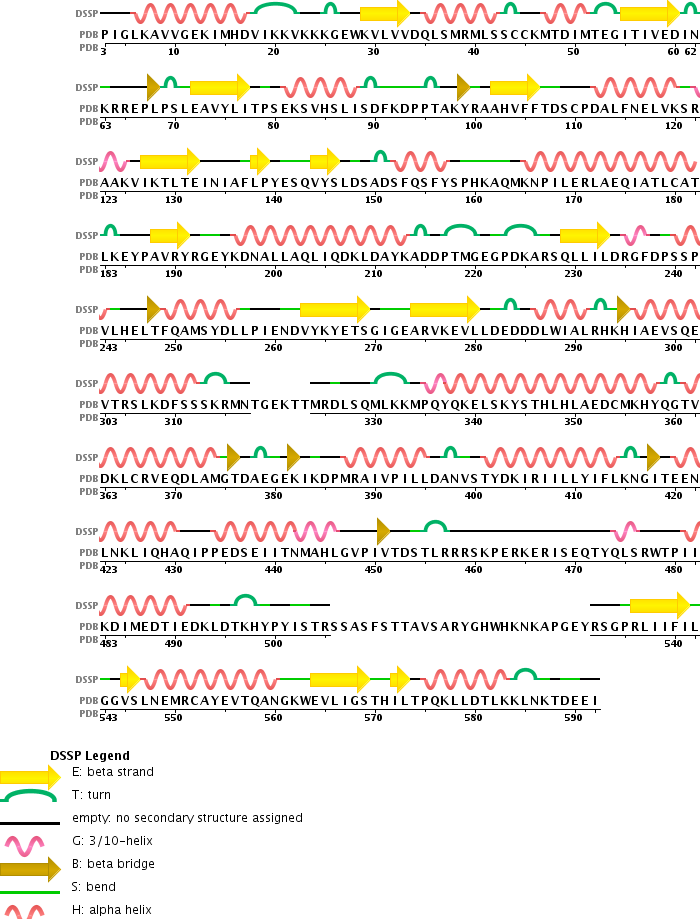Syntaxin-Binding Protein 1 (STXBP1), encoded by a gene on chromosome 9 of the same name, is a protein considered part of the Sec1/Munc18 family of proteins. In the picture on the right, there are actually two chains, A and B. These chains represent two sequence-unique entities. Chain A (pictured in grey), which is the STXBP1 strand, consists of 590 amino acid residues. Of these, 248 residues make up 26 alpha helices while 80 residues make up 23 strands of beta sheet. This peptide chain is in the L conformation meaning it is a mirror image of the D conformation while maintaining the same sequence.
 Chain B (pictured in green) is actually syntaxin A1 already bound to the STXBP1, and it contains 242 total residues. 170 residues make up 8 alpha helices here and one residue is responsible for one beta sheet. This peptide is also in the L conformation. These two chains can be bound in two different ways: to the N-terminus which is thought to cause interactions with SNARE proteins, and via a "closed" conformation which is thought to inhibit interactions.
Chain B (pictured in green) is actually syntaxin A1 already bound to the STXBP1, and it contains 242 total residues. 170 residues make up 8 alpha helices here and one residue is responsible for one beta sheet. This peptide is also in the L conformation. These two chains can be bound in two different ways: to the N-terminus which is thought to cause interactions with SNARE proteins, and via a "closed" conformation which is thought to inhibit interactions.
Function
STXBP1 is responsible for the regulation of membrane fusion through interactions with the family of SNARE proteins, syntaxin (a transmembrane attachment protein receptor). This is necessary for neurotransmission. The syntaxin assembles SNARE complexes which contain an open conformation of syntaxin A1. This complex or a closed formation of syntaxin A1 interact with STXBP1 causing and inhibiting interactions respectively. It is also said to participate in regulating synaptic vesicle docking and fusion. Likely, this is the result of GTP-binding involvement.
Disease
A mutation of STXBP1 causing misfolding and cellular aggregation or the lack of the protein entirely is found to be responsible for early infantile epileptic encephalopathy (EIEE). Also called Ohtahara syndrome, this disease is found within the first 3 months of life and is characterized by poor suckling reflexes, hypotonia(floppy baby syndrome) and seizures that can present alone or in clusters and last up to ten seconds. EIEE can lead to retardation, severe motor deficits, and even death. Researchers propose that this disease is caused by a haploinsufficiency due to the mutant STXBP1 gene drawing STXBP1 wild-type into aggregates and decreasing the level of function. Without gene function, the STXBP1 protein is either not made properly or not made at all.
References
1. Colbert, K., Hattendorf, D., Weiss, T., Burkhardt, P., Fasshauer, D., & Weis, W. (n.d.). Syntaxin1a variants lacking an N-peptide or bearing the LE mutation bind to Munc18a in a closed conformation. Retrieved May 02, 2017, from http://www.rcsb.org/pdb/explore/explore.do?structureId=4JEU
2. Database, G. H. (n.d.). STXBP1 Gene(Protein Coding). Retrieved May 05, 2017, from http://www.genecards.org/cgi-bin/carddisp.pl?gene=STXBP1#pathways_interactions
3. Deshpande, M., & Rodal, A. A. (2016). Beyond the SNARE: Munc18-1 chaperones α-synuclein. The Journal of Cell Biology, 214(6), 641-643. doi:10.1083/jcb.201608060
4. European Bioinformatics InstituteProtein Information ResourceSIB Swiss Institute of Bioinformatics. (2017, April 12). Syntaxin-binding protein 1. Retrieved May 07, 2017, from http://www.uniprot.org/uniprot/P61764
5. Hypotonia. (n.d.). Retrieved May 02, 2017, from https://medlineplus.gov/ency/article/003298.htm
6. INSERM US14 -- ALL RIGHTS RESERVED. (2014, July). The portal for rare diseases and orphan drugs. Retrieved May 02, 2017, from http://www.orpha.net/consor/cgi-bin/OC_Exp.php?Expert=1934
7. Kavanagh, D. M., Smyth, A. M., Martin, K. J., Dun, A., Brown, E. R., Gordon, S., . . . Duncan, R. R. (2014, December 17). A molecular toggle after exocytosis sequesters the presynaptic syntaxin1a molecules involved in prior vesicle fusion. Retrieved May 05, 2017, from https://www.nature.com/articles/ncomms6774
8. Peptidomemetic. (n.d.). Retrieved May 02, 2017, from https://en.m.wikipedia.org/wiki/Peptidomimetic#
9. Syntaxin. (2017, April 24). Retrieved May 02, 2017, from https://en.m.wikipedia.org/wiki/Syntaxin

